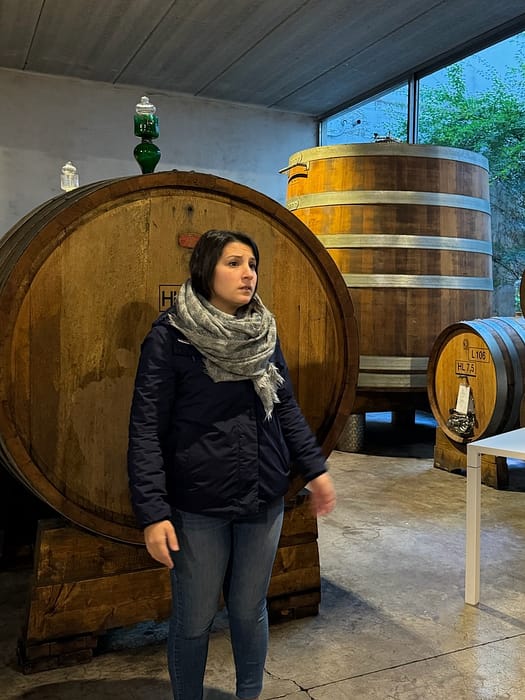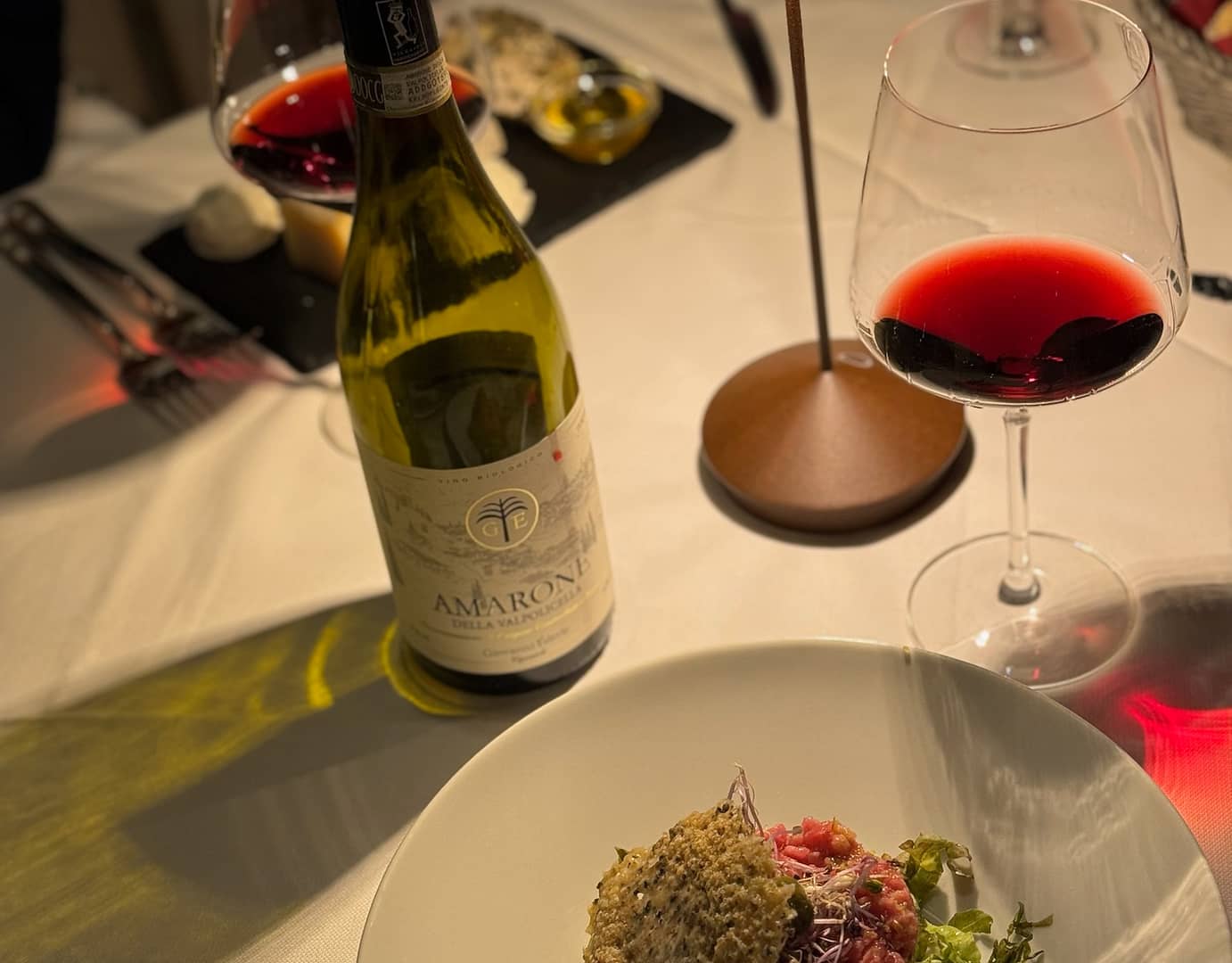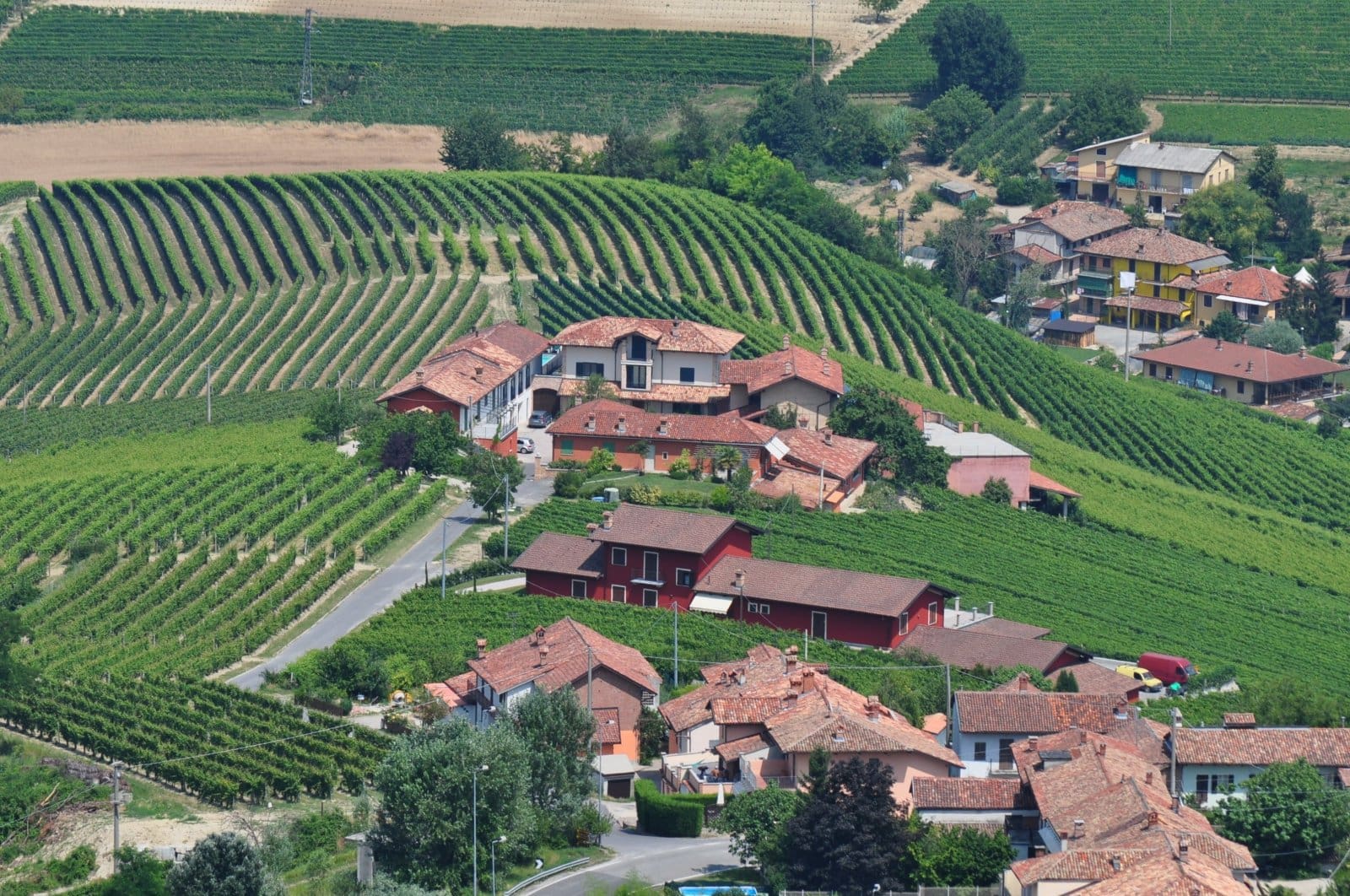Prologue: The Sun Rises over Alta Langa
As dawn painted the sky in hues of rose and gold, we awoke in the embrace of Villa Alta Langa. The promise of a day in Barolo, a realm synonymous with sublime wines and rolling vineyards, lay ahead. The air was thick with anticipation, and the echoes of dreams from the night lingered as we embarked on a journey through the storied landscapes of Langhe.
Act I: G.D. Vajra – Where Elegance Meets Expression
Arriving at G.D. Vajra, the winery’s name echoed like a lyrical sonnet, resonating with a history woven into the very fabric of Barolo. Our guide for the day, Natascia, embodied the charm and hospitality for which this region is renowned. She led us through the labyrinth of barrels, vines, and the heart of the winemaking process with an infectious enthusiasm that only intensified with each step.

Aldo and Milena Vaira, the custodians of this vinous haven, welcomed us with a warmth that transcended the traditional roles of host and guest. The vineyards, meticulously cared for and caressed by the Piedmontese sun, seemed to whisper secrets to those willing to listen.
Intermezzo: Natascia’s Ode to Beauty
Natascia’s voice, both passionate and melodic, echoed through the caverns of barrels as she spoke of beauty in all its forms. In times that tested the human spirit, she articulated a sentiment that resonated deeply—a belief in the transformative power of art, poetry, music, literature, and wine. In the cellars of G.D. Vajra, these weren’t just commodities; they were vessels of solace, conduits to a higher plane of existence.
“Art,” she declared, “is the soul’s rebellion against the harshness of reality.” In poetry, she found verses that could mend the wounds of the world. Music, she proclaimed, was the universal language that transcended borders and healed divides. Literature, in her eyes, was a refuge, a place where the weary could find solace. And wine, oh, wine was the elixir that united them all—a nectar that elevated the human experience.
Act II: Tasting Elegance in Every Sip
The tasting room at G.D. Vajra unfolded like a gallery of sensory delights. Glasses clinked like brushes on a palette as we delved into the repertoire of their wines. The Barolo, a symphony of Nebbiolo, danced on the palate with notes of red berries and delicate floral undertones. The Langhe Nebbiolo showcased the variety’s versatility, offering a youthful exuberance with a promise of aging gracefully.

As Natascia guided us through each pour, her words were not just descriptors; they were verses in a wine-infused epic. The wines, like well-composed symphonies, unfolded in movements, revealing layers of complexity and grace.
Epilogue: A Tapestry Woven in Barolo
As the day in Barolo drew to a close, the sun dipped below the hills, casting a warm glow over the vines. Aldo and Milena bid us farewell, their smiles etched with the satisfaction of sharing their labor of love. Natascia’s parting words lingered in the air like a benediction—a reminder that in the communion of art, poetry, music, literature, and wine, we find not just pleasure but a balm for the soul.
In the golden twilight, we reflected on the day—an odyssey of the senses, a symposium of the soul. G.D. Vajra had not merely poured wines; they had shared a narrative, a glimpse into the essence of Barolo and the enduring spirit of the Langhe. Each bottle was a brushstroke in the ever-evolving canvas of this enological masterpiece.
As we left the vineyards behind, the echo of Natascia’s words lingered—the idea that in embracing beauty, in all its myriad forms, we find not just an escape but a source of strength. Barolo, with its wines and the embrace of G.D. Vajra, had become a testament to the resilience of the human spirit, a celebration of the profound beauty that could be found even in the midst of adversity.



























 Toward the southern part of the Piedmont, nestled up against the Appenines and draped over hills where the fog in autumn slides in like a protective blanket against the coming (often snow-filled) winters, you can find the Nebbiolo vineyards of the Barolo DOCG, Italy’s “King of Wines.” That’s quite a reputation to live up to, considering that there are 59 different wines designated as DOC (Denominazione di Origine Controllata) or DOCG (Denominaze di Origine Controllata e Garantita) – in the Piedmont region alone.
Toward the southern part of the Piedmont, nestled up against the Appenines and draped over hills where the fog in autumn slides in like a protective blanket against the coming (often snow-filled) winters, you can find the Nebbiolo vineyards of the Barolo DOCG, Italy’s “King of Wines.” That’s quite a reputation to live up to, considering that there are 59 different wines designated as DOC (Denominazione di Origine Controllata) or DOCG (Denominaze di Origine Controllata e Garantita) – in the Piedmont region alone. ome a leader in this innovation – innovation for which he paid quite a price in the early days of the Barolo revolution, even to the point of being disinherited by his traditionalist father at one point for his progressive views and actions. That paternal treatment seems less harsh when you learn that Elio, in an effort to get his father to leave behind his traditional methods, took a chainsaw to the old, decayed, over-used and definitely un-hygienic barrels in the family winery! Eventually, Elio was restored to favor, and he brought significant changes to the family’s wine making including banning all pesticides and focusing on the health of the soil and the vines in addition to cleaning up the winery and improving vinification techniques.
ome a leader in this innovation – innovation for which he paid quite a price in the early days of the Barolo revolution, even to the point of being disinherited by his traditionalist father at one point for his progressive views and actions. That paternal treatment seems less harsh when you learn that Elio, in an effort to get his father to leave behind his traditional methods, took a chainsaw to the old, decayed, over-used and definitely un-hygienic barrels in the family winery! Eventually, Elio was restored to favor, and he brought significant changes to the family’s wine making including banning all pesticides and focusing on the health of the soil and the vines in addition to cleaning up the winery and improving vinification techniques. es a dilemma. Do we (Lisa and I, since of course they are HER wines, too!) enjoy these individually, each worthy of it’s own slow, lazy evening of appreciation? In my mind I’m immediately transported back to many evenings in Italy where the wine, the conversation, the poetry, the music all dissolved into a perfect starlit Tuscan sky. Now that’s compelling!
es a dilemma. Do we (Lisa and I, since of course they are HER wines, too!) enjoy these individually, each worthy of it’s own slow, lazy evening of appreciation? In my mind I’m immediately transported back to many evenings in Italy where the wine, the conversation, the poetry, the music all dissolved into a perfect starlit Tuscan sky. Now that’s compelling!





